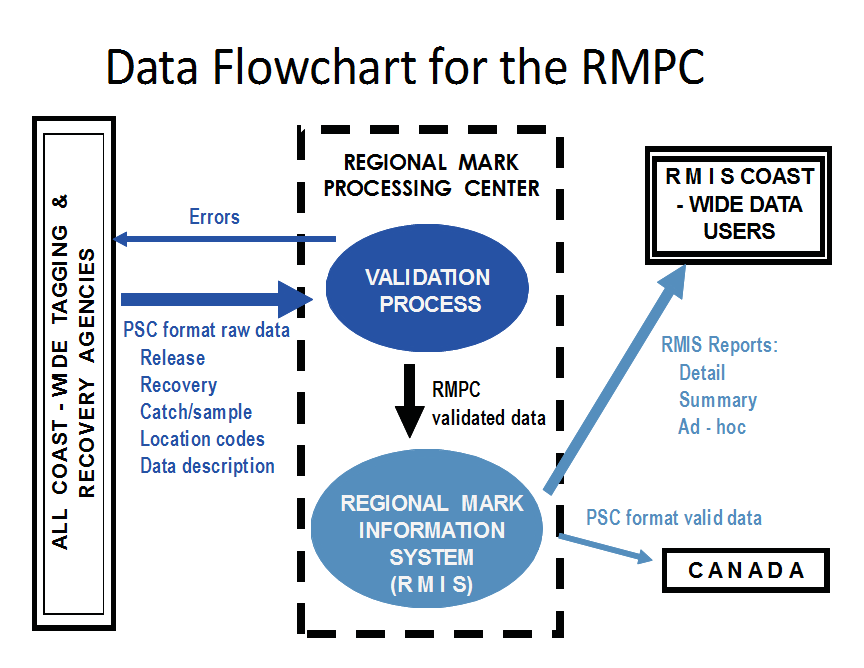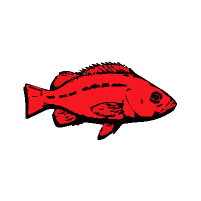RMIS Evolution
Current RMIS
The RMPC serves the needs of Pacific Salmon Commission (PSC) member agencies as well as other agencies.
PSC participants (Alaska, British Columbia, Washington, and Oregon) require a well designed CWT information system to meet management and research needs within the scope of the Pacific Salmon Treaty requirements. Non-PSC participant needs in the Columbia Basin, Oregon, and California are much broader than those of PSC participants. Therefore, given the constituency of the RMPC, any information system upgrade to meet PSC needs must be done in a fashion that continues to meet the needs of all member agencies.
For this reason, the RMPC adopts PSC data formats and standards defined by the PSC Technical Committee on Data Sharing and considers the PSC participants needs as a subset of the entire regional user community. Services provided by the RMPC are maintained, upgraded, and expanded as time and funding permit to support PSC and non-PSC access to marking and tagging information including providing on-line access to summary files of CWT recovery and catch/sample data.
Database Elements
The Pacific States Marine Fisheries Commission hosts the Regional Mark Processing Center (RMPC). This office maintains the on-line Regional Mark Information System (RMIS) to facilitate exchange of CWT data among release agencies, sampling & recovery agencies, and other data users. The RMPC also serves as the U.S. site for exchanging U.S. CWT data with Canada for Pacific Salmon Treaty purposes. Canada houses a second complete copy of Pacific coast wide CWT data sets.
RMIS houses information relating to the release, sample, and recovery of coded wire tagged salmonids throughout the Pacific region. These data flow to the RMPC in the form of files sent by electronic transfer, and must meet stringent validation criteria for inclusion in the permanent database.
Users of the RMIS application must be familiar with the current version of the “CWT Data File Definition, Specification & Validation”. It is very important that users of CWT data understand the information contained in this document in order to perform conclusive, accurate and responsible analysis of these data.
There are four main classes of CWT data: Releases, Catch/Samples, Recoveries, and Locations.
Flowchart showing flow of datasets through the PSMFC RMPC.
The data flow process of the RMPC is shown in this figure. The CWT data are submitted to the RMPC where they are loaded and validated against an extensive set of checks. These checks are to verify the integrity and accuracy of the data elements. Two elements of critical importance are: (1) the number of fish released with the CWT for each tagged release group; and (2) the number of estimated recoveries for each reported observed tag recovery.
Once validated, the data are moved into the relational database and made accessible via RMIS. Likewise, validated datasets are posted to Canada (CDFO) on a regular basis as specified in the bilateral Pacific Salmon Treaty.
Origins & Development of RMIS
Following the establishment of the data exchange standards for CWT data in 1977, the RMPC (located at ODFW offices) was known generally as the ‘RMPC CWT Database’. It was managed by Grahame King and hosted on ODFW’s MicroData system — a mainframe computer and resided in the ‘PICK’ database management system (DBMS). PSMFC began hosting the database in 1984 under the direction of Dr. Ken Johnson and it resided on an ADDS Mentor (Zilog80 based) system — still using PICK. Reports of the data were hardcopy printouts sent by mail upon specific request. There were also regular (often yearly) listings of Releases-to-date published by the RMPC.
In 1988 the RMPC CWT Database and PICK DBMS was moved to a Digital Computer ‘MicroVAX II’ host system. This period (1988 to 1992) was also when the Regional Mark Information System (RMIS) was developed and introduced as an on-screen ‘bulletin board’ — in which the user could for the first time access the DBMS online. They could dial up via modem, enter their own selection criteria to retrieve a specific data subset, choose from a variety of report output formats — and finally download the report directly to their workstation.
In 1992 the RMPC migrated the database from PICK into a new DBMS system ‘Ingres’ — a Relational DBMS based on ‘University Ingres’ (developed at UC-Berkeley). This period also saw the introduction of the Internet for RMIS, and hosted on UNIX-based systems. The RDBMS was housed first on a ‘Sequent S81’ system, then in 1998 on a Sun Microsystems SparcServer computer.
By the end of 1999, RMIS was re-designed by Steve Roti (of Olympic Software) for the World Wide Web (WWW) and with a new architecture that took advantage of tables, views, and indexes in the relational DBMS. The new HTML/JavaScript/Perl-based application was easier to maintain and became known coastwide for high speed and performance in reporting. It is now known as the ‘RMIS Standard Reporting System’.
RMIS also includes the RMIS Analysis Reporting (RAR) system. It was built into RMIS in 2005 — also by Steve Roti — and is based on the former “CWT Retrieval and Analysis System” (CRAS) developed originally by the Northwest Indian Fisheries Commission (NWIFC) in 1995. The reporting system is based on a summarized table of CWT recoveries maintained at the RMPC (updated twice per week). This table is aggregated by Tag Code, age cohort index, Management-Fishery, and Recovery Date Year. The RAR system allows analysis of recoveries based on Management-Fishery – which is a coast-wide alternative fishery designation to the standard PSC ‘Fishery’ code — reported through the RAR system.
This RMIS architecture was also more readily adaptable to migration onto different RDBMS software and hardware. In 2002 it was moved to an Oracle DBMS running on Dell server computers and supported by the IT department of PSMFC. Then, in a valuable cost-saving measure, in 2015 the database and RMIS were migrated to the Postgres RDBMS under the direction of RMPC Manager George Nandor. RMIS remains maintained on the Postgres RDBMS.

